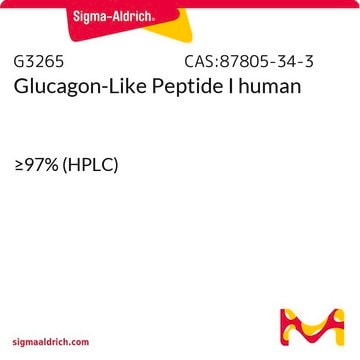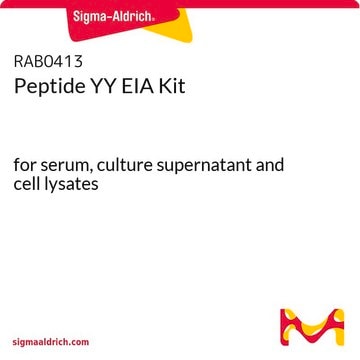EZGLP1T
Multi Species GLP-1 ELISA Kit
measures total GLP-1 levels in 20 µl - 50 µl serum, plasma or cell culture supernatent
Synonym(s):
Glucagon-like peptide-1
About This Item
Recommended Products
product name
Multi Species GLP-1 Total ELISA, EZGLP1T-36K, This Multi Species GLP-1 Total ELISA, EZGLP1T-36K, is used to measure & quantify Glucagon Like Peptide-1 levels in Metabolism research.
Quality Level
species reactivity
human, mouse, rat
packaging
kit of 1 × 96 wells
parameter
20—50 μL sample volume (4hr assay)
assay range
linearity: 90-132%
recovery range: 90-110%
sensitivity: 1.5 pM
(MinDC)
standard curve range: 4.1-1000 pM
inter-assay cv: <12%
intra-assay cv: <5%
technique(s)
ELISA: suitable
input
sample type cell culture supernatant
sample type plasma (K2 EDTA)
sample type serum
NCBI accession no.
UniProt accession no.
application(s)
research use
detection method
colorimetric (450nm/590nm)
shipped in
wet ice
storage temp.
2-8°C
Gene Information
human ... GCG(2641)
Related Categories
General description
Specificity
GLP-1 is conserved in almost all mammals.
Application
Metabolism
Disclaimer
Signal Word
Danger
Hazard Statements
Precautionary Statements
Hazard Classifications
Acute Tox. 3 Dermal - Acute Tox. 4 Inhalation - Acute Tox. 4 Oral - Aquatic Chronic 2 - Met. Corr. 1 - Skin Sens. 1
Storage Class Code
6.1C - Combustible acute toxic Cat.3 / toxic compounds or compounds which causing chronic effects
Regulatory Listings
Regulatory Listings are mainly provided for chemical products. Only limited information can be provided here for non-chemical products. No entry means none of the components are listed. It is the user’s obligation to ensure the safe and legal use of the product.
JAN Code
EZGLP1T-36K:
EZGLP1T-36BK:
Certificates of Analysis (COA)
Search for Certificates of Analysis (COA) by entering the products Lot/Batch Number. Lot and Batch Numbers can be found on a product’s label following the words ‘Lot’ or ‘Batch’.
Already Own This Product?
Find documentation for the products that you have recently purchased in the Document Library.
Customers Also Viewed
Our team of scientists has experience in all areas of research including Life Science, Material Science, Chemical Synthesis, Chromatography, Analytical and many others.
Contact Technical Service









